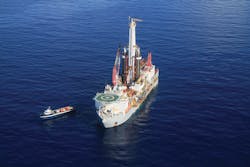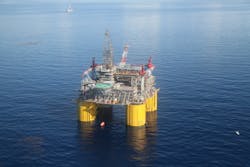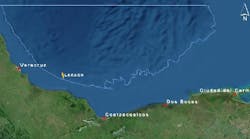Shell recently detailed its deepwater development strategy, with a particular emphasis upon its Mars B project in theGulf of Mexico. The media briefing included a simulcast from Houston and London with speakers Robert Patterson, EVP Project and Engineering Services for Shell Global Solutions in London, and Derek Newberry, Development Manager for Shell in Houston.
The purpose of the briefing, Patterson said, was to answer the question: "Why are we indeepwater and why does it matter?" He noted that deepwater is expected to play a growing role in world energy supply. Deepwater production currently accounts for 7 to 8% of the world's energy supply, mainly from areas in the Gulf of Mexico, Brazil, and West Africa.
In deepwater, Patterson noted that the main challenges include developments in remote areas; drilling in high-temperature/high-pressure environments; and operating in subsea environments with limited or no light.
In developingMars B and its other deepwater assets, Patterson noted that Shell has been able to draw upon a deepwater history that goes back to the Cognac development in 1978, and up to the existing Perdido facility, the current world record holder for deepwater operations. Shell will continue to push the envelope of deepwater development with its Stones project, which calls for the use of an FPSO in 9,500-ft waters in the Gulf of Mexico.
Patterson noted that safety is the big issue in any of its deepwater developments, and the way to address risk with floating structures was to incorporate a strict safety regime early on in the planning process. "Safety affects design," said Patterson, and Shell took steps to insure the safety of its personnel during construction of theOlympus TLP. At the same time, he recognized that it is necessary to keep deepwater projects affordable and competitive. "Deepwater has to be competitive" with other energy development projects, he observed.
The key, Patterson said, was to take learning from the past into the future. He noted that there were three cornerstones in this process: people, technology, and standardization/replication. With regard to people, Patterson noted that Shell brought its Auger experience to bear in the development of the Mars B field. "We have been fortunate enough to have a long history in deepwater," he said. Patterson also noted that Shell has a global network of trained personnel that it can tap into, and in 2005 opened a project academy to emphasize consistency. Patterson also emphasized the importance of the people in its supply chain. "Everything we accomplish, we do with others."
On the technology front, Patterson noted that Shell will employ an FPSO with a disconnectable turret on its Stones project, which will help protect people and assets in the field in the event of extreme weather.
On Mars B, Shell also made use of time lapse seismic technology to delineate the Mars B field. This included use of ocean bottom sensor technology, including ocean bottom nodes and wide azimuth (WAZ) acquisition techniques. Use of these technologies, in turn, led to better placement of infield wells, and a better understanding of waterflood performance. This will help increase overall recovery.
It was also vital to integrate all the various pieces of equipment and technology. Here, employing RFID systems enabled personnel to keep track of equipment via tablet or other handheld device, so they could know its location at any time, as well as how and where it would be installed on the TLP.
Shell was able to lower its costs on the Mars B project through standardization and repeatability. For example, using software to model lifting activities enabled the company to make those actions more safe and efficient. Going forward, Shell will employ that technique on other phases of construction, Patterson said. Enterprise frame agreements with key suppliers were also an important part of this effort, since they helped to streamline the global supply chain.
For the drilling phase, Shell deployed the next generation drilling rigNoble Bully I, which features a multi-purpose tower and can drill to depths of 10,000 ft. This new rig is also more fuel efficient than older units, which brought a fuel savings of 20 to 30%, and helped to lower emissions in the process.
In terms of replication, Shell made use of standardized components to insure that subsea trees were ready when the rig was available for work. Shell also developed a "standardized kit" which enabled global suppliers to make sure that they met the company's specification needs.
In his presentation, Newberry provided more detail on the Mars B development. Integration was the key to the success of the project, and this included integration of the topsides and other surface facilities, drilling and production equipment, and subsea components.
Another key was the global supply chain. For Mars B, Shell depended upon engineering firms, and service and supply companies from South Korea, Europe, and the US Gulf Coast. In all, some 20,000 people contributed to the work on Mars B.
Mars B is the first time significant infrastructure has been added to an existing deepwater field in the Gulf of Mexico. The original Mars field has been producing since 1996, but the size of the opportunity in the development area made it economical to build and deploy a new, second TLP to the area.
The original Mars development has produced roughly 700 MMboe to date, and Shell estimates that there are 1 Bbbl left in the area. "The richness of the opportunity set led to the bringing in of theOlympus TLP," said Newberry. These developments, in turn, are expected to extend the life of the field to 2050 and beyond.
The Mars B development incorporates the latest drilling and production systems, Newberry observed. TheOlympus TLP has 24 well slots and a self-contained drilling rig, which enables crews to drill deeper into the reservoir. It also includes a tieback to West Boreas/South Deimos area, which has six subsea wells.
Newberry noted thatOlympus is Shell's sixth TLP in the GoM, and observed that it uses a passive hull concept that incorporates lessons learned from the Perdido spar, with regard to shape of the column and placement. First oil was produced from the Mars B field in the first quarter of this year.








